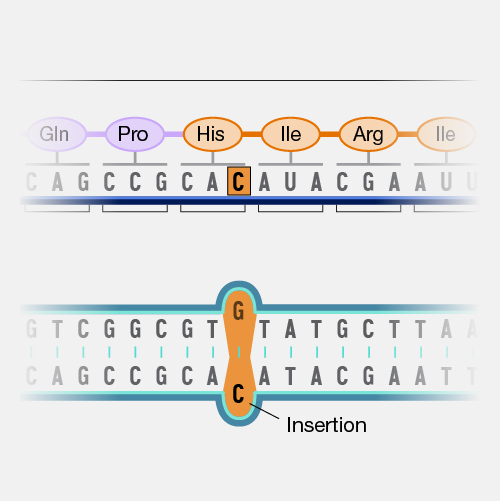A frameshift mutation is a type of genetic alteration that occurs when the sequence of nucleotides in a gene undergoes a disruption, causing the frame of reading to shift. This molecular hiccup alters the way the genetic code is decoded, often resulting in a faulty protein product, potentially disruptive to cellular functions and, ultimately, the organism’s overall well-being. Delving into the labyrinthine world of frameshift mutations unveils a fascinating interplay between genetics, molecular biology, and human health.

Image: kaos-antibakteri.blogspot.com
To understand the impact of frameshift mutations, it’s essential to appreciate the role of genes in the symphony of life. Genes, nestled within the nucleus of our cells, bear the blueprints for protein synthesis, the molecular workhorses responsible for a myriad of cellular functions. Each gene consists of a series of nucleotides – adenine (A), cytosine (C), guanine (G), and thymine (T) – arranged in a sequence akin to a genetic code, a molecular recipe for life. During gene expression, this code is decoded, enabling the production of proteins essential for the proper functioning of the organism.
The Deceptive Insertion or Deletion
Frameshift mutations arise when either an insertion or deletion of nucleotides occurs, disrupting the rhythmic flow of the genetic sequence. These mutations can be likened to an unpredictable stumbling block in the genetic code’s smooth reading, forcing the ribosome, the protein-synthesizing machinery of the cell, to jump forward or backward along the genetic sequence. Imagine a recipe where a word is inadvertently added or omitted, potentially altering the entire dish; the delicacy of genetic code introduces similar vulnerabilities to our molecular cuisine.
With the reading frame shifted, the ribosome continues to scan the genetic code, but now the sequence of triplets, known as codons, has been altered. A shifted frame leads to incorrect codon interpretation, resulting in a cascade of changes affecting the amino acid sequence of the protein. This ripple effect can range from inconsequential to catastrophic, depending on the nature of the mutation, the protein affected, and the organism’s tolerance for such deviations.
Illustrating the Impact: Frameshift Mutations in Action
Unraveling the consequences of frameshift mutations unveils a diverse landscape of effects that can impact organisms in unexpected ways. Consider the tale of the cystic fibrosis transmembrane conductance regulator, or CFTR, a protein whose production is governed by a gene. In individuals with cystic fibrosis, a frameshift mutation within this gene introduces a premature stop codon, prematurely curtailing protein synthesis. The resulting defective CFTR protein impairs the proper regulation of chloride ions across cell membranes, giving rise to the characteristic symptoms of cystic fibrosis, such as thickened mucus and impaired lung function.
Frameshift mutations have also been implicated in various types of cancer, including lung, breast, and colorectal cancers. In these instances, the mutations often result in the production of truncated, malfunctioning proteins, which may confer a growth advantage to cells, allowing them to evade normal cellular checks and balances and multiply uncontrollably, fueling tumor formation.
The Evolutionary Landscape of Frameshift Mutations
Examining the evolutionary landscape of frameshift mutations unveils a complex tapestry of influence. While such mutations can have immediate and often detrimental effects, they can also serve as the driving force behind genetic diversity, the cornerstone of evolutionary adaptation. The introduction of new variations into the gene pool, although potentially disruptive, provides the raw material for natural selection, the selective pressure that favors advantageous traits over generations.
Fascinatingly, certain organisms have harnessed the power of frameshift mutations to their advantage. In some species, programmed frameshifting is employed as a sophisticated mechanism to regulate gene expression, offering a unique insight into the intricate complexities of genetic regulation.
Conclusion: Frameshifts as Genetic Wild Cards
Frameshift mutations stand as enigmatic players in the realm of molecular biology. Their ability to disrupt genetic sequences and alter protein synthesis imbues them with the power to influence the health and characteristics of organisms, from人类to the humblest of microbes. These molecular anomalies serve as a stark reminder of the delicate balance of life, where even seemingly insignificant changes can cascade into far-reaching consequences throughout the living world.

Image: www.genome.gov
Which Is A Frameshift Mutation Brainly